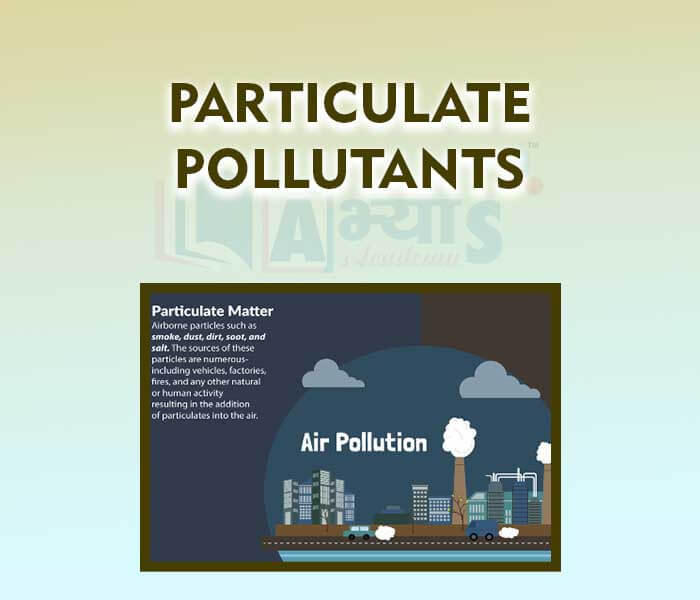Particulate Pollutants









Particulate Pollutants
A pollutant is a substance or energy introduced into the environment that has undesired effects, or adversely affects the usefulness of a resource.There are basically two types of pollutants :-
Primary pollutants :-
Pollutants that are formed and emitted directly from particular sources.The source can be either a natural process such as sandstorms and volcanic eruptions or anthropogenic such as industrial and vehicle emissions. Examples are carbon monoxide, nitrogen oxide and sulfur oxide.
Secondary pollutants :-
Secondary pollutants are defined as pollutants in our environment that are formed when other primary pollutants interact with the atmosphere. Unlike primary pollutants, which are air, water or soil pollutants that are emitted directly from a particular source, secondary pollutants pollute our environment indirectly and are not emitted from source, but are activated or synthesized by other pollutants as they are emitted. Secondary pollutants include ground-level ozone, acid rain and nutrient enrichment compounds
Particulate Pollutants
These are the pollutants that are in the form of minute particles. It may be solid (like dust, sand, tobacco and smoke) or liquid (as water droplets, mist, fog). The particulate matter remains suspended in the atmosphere and are therefore, termed as Suspended Particulate Matter (SPM). The suspended particulate matter in air is also known as Aerosol.
These tiny particles are also produced by automobiles. These are fine particles of carbon. Very fine SPM enter our lungs with the air we breathe in. They are the major cause of lung diseases. SPM settles on plants and interferes with photosynthesis. SPM reduce visibility, especially during winters. The presence of SPM is also visible in such areas where factories are located.
Sources of SPM includes construction sites, unpaved roads, smokestacks or fires. Most particles form in the atmosphere as a result of complex reactions of chemicals such as sulfur dioxide and nitrogen oxides, which are pollutants emitted from power plants, industries and automobiles.
Particulate pollution comes in all shapes and sizes, but is generally grouped into three categories : coarse, fine and ultra fine. Particles that are 10 micrometers() in diameter or smaller pose the greatest problems.These smaller particles generally pass through the nose and throat and enter the lungs. PM 2.5 and PM 10 are minute particles present in the air and exposure to it is very harmful for health. When the level of these particles increases and penetrate deeply in to the lungs and causes different health issues.
What is the size range of particulate matter which causes the most harm ? | |||
| Right Option : C | |||
| View Explanation | |||
Particulate pollutants are fine particles of __________________ | |||
| Right Option : A | |||
| View Explanation | |||
Ozone layer in upper atmosphere ( stratosphere ) is destroyed by ______________________ | |||
| Right Option : C | |||
| View Explanation | |||
Students / Parents Reviews [10]
It was a good experience with Abhyas Academy. I even faced problems in starting but slowly and steadily overcomed. Especially reasoning classes helped me a lot.

Cheshta
10thI have spent a wonderful time in Abhyas academy. It has made my reasoning more apt, English more stronger and Maths an interesting subject for me. It has given me a habbit of self studying

Yatharthi Sharma
10thA marvelous experience with Abhyas. I am glad to share that my ward has achieved more than enough at the Ambala ABHYAS centre. Years have passed on and more and more he has gained. May the centre flourish and develop day by day by the grace of God.

Archit Segal
7thMy experience was very good with Abhyas academy. I am studying here from 6th class and I am satisfied by its results in my life. I improved a lot here ahead of school syllabus.

Ayan Ghosh
8thBeing a parent, I saw my daughter improvement in her studies by seeing a good result in all day to day compititive exam TMO, NSO, IEO etc and as well as studies. I have got a fruitful result from my daughter.

Prisha Gupta
8thMy experience with Abhyas is very good. I have learnt many things here like vedic maths and reasoning also. Teachers here first take our doubts and then there are assignments to verify our weak points.

Shivam Rana
7thMy experience with Abhyas academy is very good. I did not think that my every subject coming here will be so strong. The main thing is that the online tests had made me learn here more things.

Hiya Gupta
8thIt was good as the experience because as we had come here we had been improved in a such envirnment created here.Extra is taught which is beneficial for future.

Eshan Arora
8thIt has a great methodology. Students here can get analysis to their test quickly.We can learn easily through PPTs and the testing methods are good. We know that where we have to practice

Barkha Arora
10thAbhyas Methodology is very good. It is based on according to student and each child manages accordingly to its properly. Methodology has improved the abilities of students to shine them in future.
